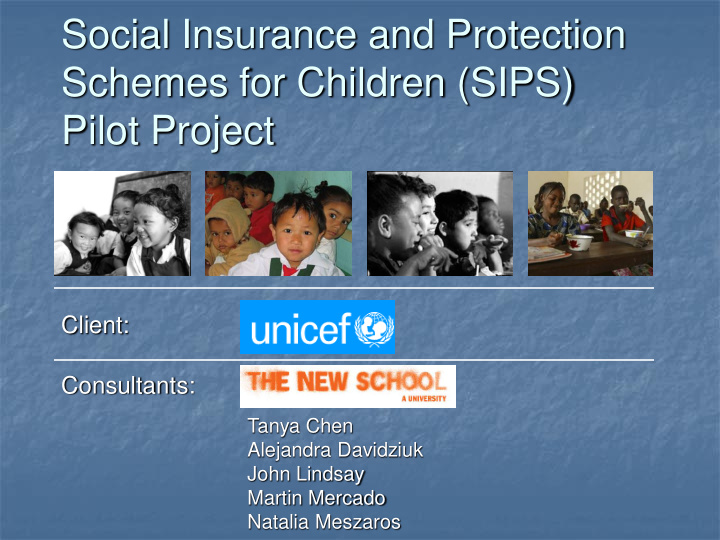



Social Insurance and Protection Schemes for Children (SIPS) Pilot Project Client: Consultants: Tanya Chen Alejandra Davidziuk John Lindsay Martin Mercado Natalia Meszaros
Background There currently exists disparate social assistance programmes. Potential programme of “International Child and Family Support”. The potential goal is to help low and middle income countries initiate children’s protection programmes. We are the consultants for this pilot project
Outcomes Literature Review To understand current dialogue, theory and existing programmes regarding children’s social protection. Classification of Programmes Theoretical foundation of project Institutional Mapping Country specific programme research
Social Protection Definition Deprivation Three commonalities: Vulnerability Social and and Risk Universal Vulnerability and risk Policies Levels of deprivation deemed unacceptable Policies and programmes that are both social and universal in character
Social Protection Definition “A collection of measures to improve or protect human capital, ranging from labor market interventions, publicly-mandated unemployment or old- age insurance to targeted income support.” World Bank “Policies and programmes designed to reduce poverty and vulnerability by promoting efficient labour markets, diminishing people’s exposure to risks, and enhancing their capacity to protect themselves against hazards and the interruption/loss of income.” Asian Development Bank Public actions taken in response to levels of vulnerability, risk or deprivation which are deemed socially unacceptable within a given society. UK Department for Intl. Development
Creating a New Definition Important themes Universality Threshold Programmes Focusing on Children
Our Working Definition “Policies and programmes that strengthen those public and private institutions that support all children whose vulnerabilities increase beyond a socially acceptable level.”
Classification of Programmes Cash Transfers In-Kind Transfers Tax Benefits / Tax Credits National Legal Framework Additional Policies
Classification of Programmes Policy Types Cash Transfers In-Kind Transfers Unconditional Conditional Unconditional Conditional Education Education Education Education Health Health Health Health Family Family Family Family Child/family Child/family Child/family Child/family allowances allowances allowances allowances Lone parents Lone parents Lone parents Lone parents Unemployment Unemployment Unemployment Unemployment benefits benefits benefits benefits Housing Housing Housing Housing Multi-generational Multi-generational Multi-generational Multi-generational Vulnerable children Vulnerable children Vulnerable children Vulnerable children
Institutional Mapping Bangladesh Brazil Indonesia Jamaica Kenya Food For Abono Salarial Special Market Programme for Cash Subsidy Education Operations for Advancement for Children Young Program Rice Through Health Affected by HIV Income of Social and and Education and AIDS Generation Human Scholarship and Vulnerable Development Block Grant for Primary School Group Program Primary and Child Development Junior; or Higher Deworming Bolsa Família Education. Project Primary Sentinela Education Social Safety Net National Centre Programme Stipend Program for the Health for Childhood Eradication of Sector Education Rural Child Labor Maintenance Early Childhood Programme Program Development Serviços de Project Bangladesh Ação Continuada Integrated Nutrition Program
Institutional Mapping Policy Type Year started and length of programme Agencies involved Programme description Targeting Conditionalities Coverage (how many people, households) Cost Programme sources
Institutional Mapping Bangladesh Food For Education (FFE) Policy Type – Conditional In-Kind Transfer, changed to Conditional Cash Transfer. Year started and length of programme – 1993. Coverage: 27% of all primary school (2000), 2.1 million household (2000) Cost: US$0.10/student/day – US$77million (2000)
Conclusion What we did Initial Literature Review Existing definitions of Social Protection Our definition of Social Protection Constructed Conceptual Framework Country Specific Research Institutional Mapping
Conclusion Why we did it There is a lack of research on: The theory of “children’s social protection” What policies / programmes exist No standard definition No standard conceptual framework No comprehensive database or institutional mapping
Conclusion Why what we did was important This pilot project could be the foundation for a comprehensive database The database could support a UNICEF programme of International Child and Family Support A policy initiative to support social security type benefits for children worldwide
Conclusion What was learned There is a lack of basic information on what a children’s social protection programme should include There is a lack of information on what programmes currently provide social protection for children When information does exist it is often old, contradictory or incomplete The research for this report ended up proving the need for this report, and the vital need for continued in- depth research in to children’s social protection
Conclusion THANK YOU
Recommend
More recommend